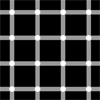Session Overview

|
This session is an introduction to the subject of psychology: the scientific study of how we think, feel and act. The lecture features some fascinating examples and fun demonstrations on topics like optical illusions, limits of visual attention, the power of suggestion in memories, and the relationship between how we feel and how we act. Keywords: perception, optical illusion, visual memory, visual attention, listening, automaticity, prediction, thinking, feeling, acting In the Hermann Grid illusion, black dots seem to flash in the grid intersections. (Public domain image.) |
Session Activities
Readings
Read the following before watching the lecture video.
- One of the following textbook chapters:
- [K&R] Chapter 1, “Introduction to the Science of Psychology: History and Research Methods”
- [[Stangor]](/courses/9-00sc-introduction-to-psychology-fall-2011/pages/syllabus#Stangor) Chapter 1, “Introducing Psychology”
Lecture Videos
View Full Video
View by Chapter
- Goals of the Course
- How Our Minds Make Our Worlds: Vision, Memory, Attention
- How Our Minds Make our Worlds: Hearing, Learning, Memory
- The Power and Peril of Automaticity
- How We Feel vs. How We Act
Video Resources
Further Study
These optional resources are provided for students that wish to explore this topic more fully.
| TYPE | CONTENT | CONTEXT |
|---|---|---|
| Animation | MIT Perceptual Science Group. Lightness Perception and Lightness Illusions. | More from this source used in the lecture video: eleven animations based on a paper by Edward H. Adelson. |
| Animation | Bach, Michael. 92 Visual Phenomena & Optical Illusions. | More from this source used in the lecture video: animations of optical illusions. |
| Videos | Visual illusion experiments by Prof. Richard Gregory | More from this source used in the lecture video: includes the rotating Charlie Chaplin mask illusion. |
| Web resource | History of Psychology: Contemporary Foundations. Discovering Psychology. WGBH Educational Foundation, 2001. | Timeline of key events, publications and perspectives in the development of psychology, from late 19th century to the present. |
| Textbook supplement | Study materials for Ch. 1, “Psychology: Yesterday and Today.” In Kosslyn & Rosenberg, Psychology in Context, 3/e (Pearson, 2007) | Practice test questions, flashcards, and media for a related textbook. |










